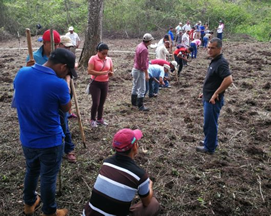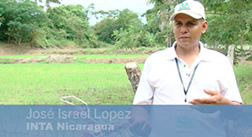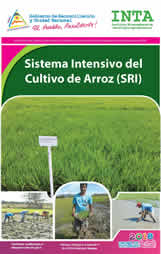Nicaragua
[in Spanish]
Overview
While Nicaragua was represented at the First International Workshop on SRI for Latin America and the Caribbean in 2011, SRI evaluations only began in 2016 under the direction of Engineer José Israel López Rodríguez at the Nicaraguan Institute of Agricultural Technology (INTA). During 2015, INTA provided information on SRI to producers in regions 4 (the Department of Rivas) and 6 (the Departments of Jinotega and Matagalpa) and held socialization workshops to present the methodology to local producers. Finally, in 2016, they established validation plots with the producers in the field. Initially, the producers were hesitant to accept the SRI methodology as it was very different from what they were familiar with. With time though, producers have been impressed by the results, and adoption of SRI methods is increasing. Nicaraguans are confident in the future of SRI in their country and are spreading this knowledge with other farmers. For more information, watch this video with Engineer José Israel López Rodríguez.
Progress and Activities
 2019 Activities
2019 Activities
 SRI Training for Smallholder Rice Farmers in Nicaragua
SRI Training for Smallholder Rice Farmers in Nicaragua
[June 28, 2019] The NGO Earth Links completed an SRI training for smallholder rice farmers in Matagalpa, Nicaragua, on June 3-5, 2019. The project is a collaboration with four partners: Three Americas, the Association for the Diversification and Development of Agricultural Community (ADDAC), SRI-Global and the Inter-American Institute for Cooperation in Agriculture (IICA). The training, which took place on a site selected by ADDAC, included, thirty men and women farmers and three agricultural technicians, who may go on to become become trainers. The group was introduced to SRI by a lead trainer from IICA, Diddier Moreira. Instruction was followed by hands-on planting of seeds in a grid pattern; training materials were distributed to the participants. Follow-up visits will occur as needed by IICA staff in Nicaragua. Earth Links hopes to carry out similar work on the volcanic island of Ometepe, where rice farming faces challenges with both yield and over-use of pesticides. [See Earth Links article]
2017 and 2018 Activities
 The Second Regional Exchange: Advances with SRI in the Americas
The Second Regional Exchange: Advances with SRI in the Americas
[December 15, 2017] Nicaragua participated in the Second Regional Exchange: Advances with SRI in the Americas, which took place in Ibagué, Colombia from October 10-12, 2017. During the meeting, participants from the countries of Colombia, Argentina, Costa R
 ica, Cuba, the Dominican Republic, Ecuador, Nicaragua, Panamá, Trinidad-Tobago,and Venezuela presented the results of their experiences with SRI with the objective of exchanging information, lessons learned and opportunities for adapting SRI in the Americas. This Second Regional Exchange was organized by the Inter-American Institute for Cooperation on Agriculture (IICA) and the National Federation of Rice Growers of Colombia (FEDEARROZ), within the framework of the Project "Cultivate more with less: Adaptation, validation and promotion of the intensive system of rice cultivation (SRI) in the Americas as a response to climate change." The project was financed by FONTAGRO and the GEF. José Israel López Rodríguez (at right), from the Nicaraguan Institute of Agricultural Technology (INTA), represented Nicaragua. [See Nicaragua poster and video presentation from the conference.]
ica, Cuba, the Dominican Republic, Ecuador, Nicaragua, Panamá, Trinidad-Tobago,and Venezuela presented the results of their experiences with SRI with the objective of exchanging information, lessons learned and opportunities for adapting SRI in the Americas. This Second Regional Exchange was organized by the Inter-American Institute for Cooperation on Agriculture (IICA) and the National Federation of Rice Growers of Colombia (FEDEARROZ), within the framework of the Project "Cultivate more with less: Adaptation, validation and promotion of the intensive system of rice cultivation (SRI) in the Americas as a response to climate change." The project was financed by FONTAGRO and the GEF. José Israel López Rodríguez (at right), from the Nicaraguan Institute of Agricultural Technology (INTA), represented Nicaragua. [See Nicaragua poster and video presentation from the conference.] Nicaragua's Promising Experience with SRI
Nicaragua's Promising Experience with SRI
[December 12, 2017] José Israel López Rodríguez, from the Nicaraguan Institute of Agricultural Technology (INTA), participated in the Second Regional Exchange: Advances with SRI in the Americas where he shared that the incorporation of SRI methodology in Nicaragua encourages the use of biological inputs including the application of mycorrhiza to the seeds prior to establishment. He explained that SRI principles have allowed the improvement of root development (15 cm conventional vs 25 cm SRI) and better tillering (9 tillers conventionally vs 26 tillers in SRI). The costs of inputs, however, tend to increase because organic fertilizers are more pricey and are not part of the producers' culture. Fortunately, with time, the costs are outweighed with the significant reduction of seed costs. In addition, channels have been designed in Nicaragua to measure water usage; Nicaragua has achieved a usage reduction from 25,600 m³ / ha. conventionally to 12,485 m³ / ha with SRI. Partly due to the intermittent irrigation recommended for SRI, higher yields have been achieved in the SRI plots (5,16 ton / ha. in conventional and 7.15 ton / ha with SRI) with a corresponding increase in profits of USD 325 / ha in four established plots. For this reason, some smallholder producers have begun to use SRI methodology in the production of their own seed. The next steps for Nicaragua with SRI include the establishment of more trials in the different rice-growing areas of the country, as well as greater promotion and dissemination of the methodology and its benefits through posters, radio and television programs and demonstration field days in SRI plots. [See poster and video presentations from the conference.]
 Nicaragua Participants Join
First International Workshop on SRI for Latin America and the Caribbean
Nicaragua Participants Join
First International Workshop on SRI for Latin America and the Caribbean
 INTA Launches SRI in Nicaragua
INTA Launches SRI in Nicaragua
 [May 1, 2018] On April 11th, 2018, INTA, The Nicaraguan Institute of Agricultural Technology, launched SRI methodology in Nicaragua through a field day event and an instructional/ promotional brochure. The brochure introduces the need for SRI methodology in midst of threats to Nicaragua's food security and explains the SRI process to farmers. Additionally, INTA uses it to highlight their results from research on 5 parcels, comparing yield, weight, height of plant, and other factors of SRI and conventional technologies. Currently, they have 10 SRI parcels in two regions of Nicaragua.
[May 1, 2018] On April 11th, 2018, INTA, The Nicaraguan Institute of Agricultural Technology, launched SRI methodology in Nicaragua through a field day event and an instructional/ promotional brochure. The brochure introduces the need for SRI methodology in midst of threats to Nicaragua's food security and explains the SRI process to farmers. Additionally, INTA uses it to highlight their results from research on 5 parcels, comparing yield, weight, height of plant, and other factors of SRI and conventional technologies. Currently, they have 10 SRI parcels in two regions of Nicaragua.
2011 Activities
- [November 15, 2011 ] Leonel Samayoa and Danilo Cortéz from ANAR/Arrozsemilla and Andres Samayoa from Grupo A.G.B represented Nicaragua in the First International Workshop on SRI for Latin America and the Caribbean which was held October 31 - November 1, 2011, at EARTH University, Guáncimo, Limón, Costa Rica.
Reports and Articles
- Leinau, Stephen. 2019. Our recent SRI training for smallholder rice farmers in Nicaragua. Earth Links website. June 28. [Nicaragua SRI training partners included Earth Links, ADDAC, IICA, Three Americas and SRI-Global.]
- INTA. 2018. Sistema Intensivo del Cultivo de Arroz (SRI). Brochure de INTA - Instituto Nicaragüense de Tecnología Agropecuaria (Instructional/promotional brochure by the Nicaraguan Institute of Agricultural Technology (INTA).)
- Witkowski, Kelly and Diddier Moreira. 2017. Informe segundo intercambio regional: Avances cons SRI en las Américas [Read online (slideshare.net). Also, 15MB hi-res download version; or 5MB download version without posters]. SRI-Rice website. (50p., 4MB pdf) [Spanish language document about a regional workshop related to the Proyecto Cultivar más con menos: Adaptación, validación y promoción del Sistema Intensivo del Cultivo Arrocero (SRI) en las Américas como una respuesta al cambio climático. The workshop was held October 10-12 in Ibagué, Colombia.] [See also shorter description in English.]
Presentations
- Rodríguez, José Israel López. 2017 (November 9). Avances cons SRI en las Américas - Nicaragua. Poster presentation at the Segundo Intercambio Regional: Avances cons SRI en las Américas, bagué, Colombia, October 10-12, 2017
Videos
- 2019 (July 29). Opiniónes de productores sobre SRI. 2:05 min. IICAnoticias channel, YouTube. [Farmer experiences with IICA-sponsored SRI efforts in Panana, Costa Rica and elsewhere in Latin America.]
- 2019 (July 29). 1) ¿Qué es SRI?. 2:00 min. SRI 2do Segmento. 6:10 min. SRI 3er Segmento 5:46 min. IICAnoticias channel, YouTube. [Agroconecxion TV show (in three parts) on IICA's SRI program.]
- 2015 (December 3). Entrevista Al Especialista de IICA Diddier Moreira. 7:22 min. Mercedes Fraile channel, YouTube.
- 2018 (January 18). 03 SRI - Nicaragua nuevo. 3:32 min. IICA channel, Vimeo. [Video about Nicaraguan SRI trials.]

